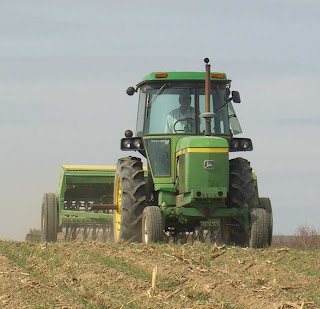
The right combination of agricultural practices and definitive government policies could go a long way toward increasing carbon sequestration on the farm, according to Washington State University researchers.
Chad Kruger, interim director for WSU's Center for Sustaining Agriculture and Natural Resource who coordinated the Climate Friendly Farming Project, says that three basic changes in traditional agricultural practices could dramatically improve farmers' ability to keep carbon.
"Basically, we're talking about three things," Kruger said. "We need to reduce disturbance of the soil, produce more biomass and make sure that biomass and plant residue make it into the soil."
Kruger said low-till or no-till production minimizes carbon oxidation and erosion -- especially important in the dryland farming areas of the Palouse and elsewhere in the state. "We don't know everything about the fate of carbon in erosion, but we definitely know we're better off if the soil stays on the hillside."
That isn't the only factor in carbon sequestration, though.
"The most important factor is getting more carbon into the soil," Kruger said.
One way is to make sure that the plant residue from current crops stays in the field, he said. "Field burning, tillage that oxidizes carbon, baling of residue all reduce the available carbon inputs."
Another way to increase carbon in the soil is to increase the amount of biomass produced. "Farmers are thinking differently about the types of crops we can grow," Kruger said. "Our dryland options are limited by rainfall, but in an irrigated system, though, we have a lot of options."
One of those options is cover cropping, which entails growing a "sacrifice" crop that will be mowed or tilled in, which in turn, provides longer-term carbon storage. Kruger offers one caveat to that option -- increasing carbon input might also increase nitrogen, and nitrous oxide, in the system. Nitrogen management is an environmental issue facing many growers.
Another option is to bring organically based amendments to the soil. "We need to beyond traditional amendments such as manure," Kruger said. "We need to look at compost, paper, municipal solid waste and biochar to increase carbon sequestration. The possibilities are really wide open, and not a lot of research has been done yet."
Understanding practices that work and developing the governmental policies to make it economically possible for growers to implement them may be two different things, however.
"Say a farmer wants to shift to no-till to get a carbon credit," Kruger said. "That change can be expensive at the front end in terms of new equipment. If a carbon credit is an annual payment of $3 to $4 per acre, that is not a very enticing incentive."
And what about the growers who dramatically changed their practices years ago? Kruger said it is still possible that "early action" could be penalized under programs currently being proposed, not with fines but by not being allowed to take advantage in new incentives.
"Carbon sequestration and the carbon markets are very difficult and tricky things to wade through," Kruger said. "The changes and results that can come from agricultural systems tend to be slow and incremental. It's a lot different than changing the kind of light bulbs you use, and the policy community has some clear reservations."
Kruger is a featured speaker at the "Understanding Carbon Markets" workshop being held at Malo, Wash., on April 24. That workshop is being sponsored by WSU Ferry County Extension, Ferry County Commissioners and the Malo Grange.




















